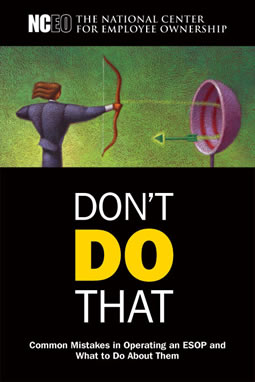
Don’t Do That: Common Mistakes in Operating an ESOP and What to Do About Them
Click to Download PDF VersionThe National Center for Employee Ownership, Oakland, California (Copyright 2010)
Web site: www.nceo.org
ISBN-10: 1-932924-70-1
ISBN-13: 978-1-932924-70-1
Chapter 6: S Corporation Issues
Page 69 and 70
By Bill Dietrich of Rubicon Valuation
Too Much Cash, or When Printing More Shares Is the Answer
A moderately successful mature S ESOP company had a material repurchase obligation. It also had many employees and managers who were relatively new to the company and had few shares. They helped build the business to even better levels of performance, but saw that their rewards for all their hard work will almost wholly go to retired employees with the largest legacy share accounts.
Like a lot of 100% ESOP S corporations, this company had quickly begun to accumulate cash during a few financially positive performance years. Because it did not have to pay tax, it could retain these accumulated earnings. Like a lot of these companies, it operated with a conservative cash-conscious strategic plan during “tough times,” such as the recent credit crisis and recession. The combination of good fiscal and operational management increased the value of the company, including when it just “held its own” during dire economic cycles.
These practices have an impact on value. The classic investment-bank valuation formula for a going concern is: Equity Value = Value of Operations Less Debt Plus Excess Assets. All things being equal, a company’s value can increase simply by adding to excess cash. That means a bigger repurchase obligation.
Management feared the repurchase obligation like an apocalypse coming to take away hard earned cash and endanger the company. Not understanding the nuances of the mighty ESOP, they forbade the issuance of new shares and were close to the limit for issuing shares that had been authorized but not yet issued. But they suddenly realized that their rewards for all their hard work will almost wholly go to retired employees with the largest legacy share accounts.
Printing More Shares to the Rescue
What to do? One approach would be to use the cash to pay bonuses to the current employees. That would keep the value and the repurchase obligation down and reward current employees. But cash is necessary during a credit crisis and short-term gains and cash giveaways are not how this company operates. Raising salaries will work as well because the increased labor costs will reduce the value, but salary increases are permanent and are hard to retract if times get even worse.
The solution is dilution. Issuing new shares increases the holdings of the current employees, and if the percentage increase in the number shares issued equals the percentage increase in the company value, then current employees are rewarded for all the value added while retired employees are not short-changed.
As noted elsewhere in this book, the trustee also needs to make sure the appraiser understands that with an ESOP, as the company value increases, the repurchase liability also increases. Depending on the size and timing of the obligation, the repurchase increase may offset a rise in company value. A repurchase obligation is comparable to an off-balance sheet debt, which if analyzed properly, will fit into the above formula and reduce a rising company value by the incremental annual increases of the repurchase obligation.
<top

